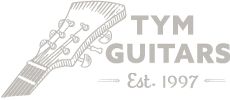1960's Astrotone
Share
If you're into vintage Japanese guitars of just into the weird and wonderful you'll probably know what this is. Or, maybe not ...
This is a mid 60's Astrotone, or more specifically a Super Astrotone and they're one of the holy grails of the vintage Japanese guitar collecting. While in reality there are a few "holy grails" some of them are so because they are such great shapes, or they made so few of them, or no-one really knew much about them. Well, this one ticks all the boxes.
Until recently they have pretty much been listed and talked about as "Guyatones, or Teiscos" as discussed in previous blogs guitars like this tended to be just "cheap Japanese guitars" because so few ever turned up for sale or they had no name on the headstock.

It's believed these were made by Suzuki which actually had two factories making violins and acoustic guitars after the company was split in two after world war 2. The most famous was the Nagoya violin company which was famous for streamlining the traditional manufacturing of violins and making them more mass produced by skilled labour rather than luthiers and in the mid 1900's were making 500 violins a day while keeping the quality and tone intact.
After the split after WW2 Suzuki resumed making violins and guitars at the Ena Gakki factory but in 1952 the factory became independent and moved to Nagoya, but continued to make musical instruments for Suzuki and continues to make violins and mandolins to this day. This was the factory that probably built these solid body guitars for Suzuki but branded as Astrotone.
These are however quite unique in the Japanese guitar world and the Suzuki solid body world and the only matching hardware found on these to other Suzuki guitars of the period like the E20 and E21T's are the bridge. These other Suzikis had more of a Zen On feel and look with "wave shaped" chrome metal scratchplates and more traditional "offset" shapes.

The body shape, headstock shape and construction doesn't match other Suzukis of the time. The pickups are unique to this model also and the vibrato, which at first glance looks like a few Japanese units like Teiscos are only found on this model. It is similar to the famous Teisco unit with horizontal springs running under the chrome cover but the arm comes out between the D and G strings, not B and E, although there are some Teisco WG3's from '65 that have VERY similar vibratos.
The bodies are laminated and quite thin. The necks are solid one piece Asian mahogany and quite thick, but VERY comfortable. The wonderful thing about these is of course, that shape. It's a very organic shape but very ... strange for a company so steeped in tradition.
This model came out in two slightly different body and headstock shapes with three different scratchplate shapes. All were chromed metal plates with rocker switches and two volumes and a master tone control. While two of these plates didn't touch the pickups, meaning you had to drill access holes through the body to feed the wiring through, one version (EG-35) did have a "full plate" with the pickups mounted in the scratchplate (see below. More on that one soon). It's a great design and the plate reminds me of a 70's Mosrite 300/350.


The pickups, which as I said before were only ever available in these actual model guitars are full and bright with plenty of depth. While they look like other brands used by companies like Fujigen, Hoshino and Kawai they are not the same and have no markings or indication who made them.

The bridge is rudimentary and runs a round "saddle" in a grooved bridge, which is offset for better intonation unlike some other similar bridges of the time. The rolling saddle helps with vibrato use and is a fascinating idea that didn't seem to catch on?
The timber quality and construction is good throughout and the electrics and hardware is all very well made. This one is all original and everything works well and it plays surprisingly good for it's relatively primitive looks.

Suzuki would of course go on to join the copy wars in the 70's and 80's and make some amazingly great electric guitars, although they will probably be more remembered for their acoustics and violins.
These Astrotones are a weird guitar in other ways too. Despite their rarity, which they are, they're not really worth a lot when they come up for sale. It may be that because the name is so unknown, and until recently, there was not much on the net about them, people put them in the "cheap no name Japanese guitar" basket but they play and sound as good as most other good quality mid 60's Japanese manufacturers and look a whole lot better than some.
It seems they were imported into the US in reasonable numbers in the mid to late 60's as most appear to be there. They are actually quite rare in Japan (and Australia) and the ones you see for sale there in Japan seem to not have the brand name on the headstock? Maybe Astrotone was the US importers name for them?
Whatever the case it's one of my "I'll keep this one 'cause it's worth more to me to keep" even though there's usually one for sale somewhere at any given time and they do (or used to) pop up as those "cheap Japanese Teisco" for a lot less than people who actually know what they are.
While some of the Japanese collector holy grails are, and will be hard to let go of, I have owned and have sold so many that they have to be kinda special to me to keep nowadays, and this one's special.









